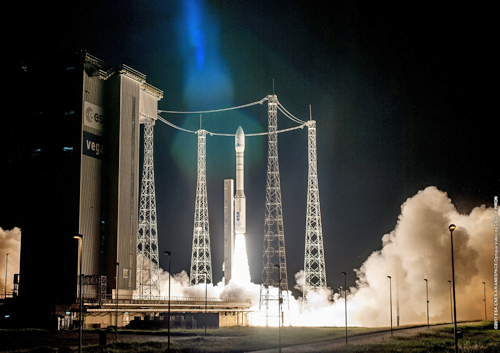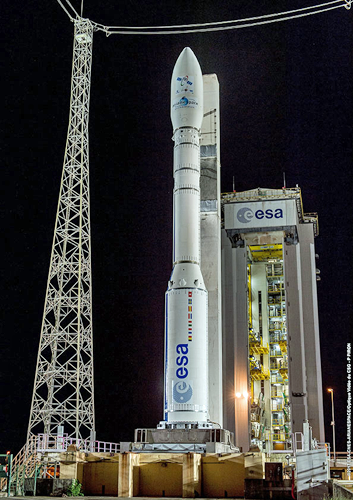
For the second time this year — and the 10th overall since entering service in 2012 — Arianespace has successfully launched a payload via the Vega rocket from the Spaceport, with this lightweight vehicle’s latest mission delivering the OPTSAT-3000 and Venµs Earth observation satellites to Sun-synchronous orbits.

The launch of Vega mission VV10 by Arianespace, photo courtesy of the company.
Lifting off from the Spaceport’s SLV launch complex at precisely 10:58:33 p.m. French Guiana time on August 1, Vega lofted its multi-passenger payload during a flight sequence lasting 1 hour, 37 minutes. Speaking from the Spaceport’s Jupiter control room, Arianespace Chief Executive Officer Stéphane Israël declared the launch a success and reflected on Vega’s new “10-for-10” operational record, which includes four of these successes achieved during the past 11 months.
He noted that in five years of activity, Arianespace's lightweight vehicle already has orbited a total of 25 satellites for 19 customers worldwide, both institutional and commercial, serving a wide range of space applications, such as Earth observation, science, technology and education.
Delivering OPTSAT-3000 for Italy
During the initial phase of the mission — designated Flight VV10 in Arianespace’s launcher family numbering system — Vega was powered by three solid propellant stages, followed by multiple burns of the bi-propellant upper stage before separate deployments of the two spacecraft.

The payload fairing, which encapsulated Flight VV10’s two satellite passengers during Vega’s ascent through the denser layers of Earth’s atmosphere, was manufactured using a new “out of autoclave” production process.
Photo is courtesy of Arianespace.
The first passenger released by Vega, OPTSAT-3000, is an Earth Observation (EO) satellite for the Italian Ministry of Defence. The satellite was built by Israel Aerospace Industries (IAI) based on inter-governmental, Italian-Israeli agreements. Once operational, OPTSAT-3000 will enable national defense entities to acquire and use high-resolution imagery from any part of the globe. The OPTSAT-3000 system was supplied by Telespazio as prime contractor, which has responsibility for the entire system; while OHB Italia was responsible for the launch services and related engineering support.
General Enzo Vecciarelli, Chief of Staff of the Italian Air Force, acknowledged the superb capabilities of a great team that was responsible for OPTSAT-3000’s development and launch. In comments at the Spaceport’s control center, he noted this launch marks another step forward in European cooperation in space, “which is something that we really need, because we live in a critical time for the security and stability environment — where there is a lack of situational awareness.”
Venµs: an Israeli-French collaboration
The second passenger orbited on Flight VV10 — Venµs, also produced by Israel Aerospace Industries — is an EO and exploratory mission for the Israel Space Agency (ISA) and France’s CNES space agency at the benefit of Israel’s Ministry of Science, Technology and Space.
Venµs (an acronym for “Vegetation and Environment monitoring on a New Micro Satellite”) will study the evolution of Earth’s vegetation during this scientific mission, while the satellite’s technological mission will provide in-flight qualification of the Israeli electrical propulsion system, based on Hall-Effect thrusters. CNES is in charge of the multi-spectral camera, its image programming and processing, as well as the distributing ground station; while the camera’s development was performed for CNES by Elbit Electro-Optic Systems, Elop Ltd.
Peretz Vazan, Director General of Israel’s Ministry of Science, Technology and Space, called the launch a “spectacular event,” and provided his “mazel tov” (congratulations, in Hebrew) to all involved in the success.
An Eye on the Future
In addition to bringing Vega’s tally of successes to double-digits, Flight VV10 also marked the rocket's first launch under a new operational organization between Arianespace and the vehicle’s production prime contractor, Italy’s Avio. The payload fairing, which encapsulated Flight VV10’s two satellite passengers during Vega’s ascent through the denser layers of Earth’s atmosphere, was manufactured using a new “out of autoclave” production process.
Under the new arrangement aimed at enhancing competitiveness, Avio now assumes responsibility for preparing the launcher until liftoff; while Arianespace maintains full responsibility for customer relations, as well as operations for the final countdown and launch decision. Reinforcing Arianespace’s continued focus on innovation, Flight VV10’s Vega also used a new “out of autoclave” payload fairing that was developed by RUAG for the next-generation Vega C launcher, with the manufacturing process also to be applied to payload fairings for the follow-on Ariane 6 heavy-lift vehicle.
Flight VV10 continues Arianespace’s busy schedule in 2017, wherein eight launches have been completed during the year’s first seven months using the company’s family of launchers (two with the lightweight Vega; two with the medium-lift Soyuz; and four using the heavy-lift Ariane 5). The company’s next mission is scheduled for early September, when Ariane 5 will lift off from French Guiana on a flight to geostationary transfer orbit with a pair of relay satellites: Intelsat 37e and BSAT-4a.

